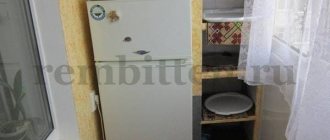When planning an apartment, the question often arises: is it possible to place a refrigerator next to a heating radiator?
This is a difficult matter that needs to be carefully considered and several nuances resolved. A large kitchen is a rarity that is not available to everyone. In addition to proper placement and redevelopment, it is important to remember the small free space that is necessary for movement.
All owners of small kitchens face the problem of placing a refrigerator. The location for the refrigeration equipment must be chosen in advance and taken care of as well. In the vast majority of cases, placing it next to the radiator is the only possible and acceptable solution. Let's consider the subtleties and nuances of this issue.
The refrigerator is the largest appliance in the kitchen, but you can’t do without it. The owners can only place it in the corners where the battery is located, however, this must be done taking into account certain rules so as not to damage the equipment.
Features of placing a refrigerator next to a radiator
Many people are interested in the question: why can’t you tolerate the proximity and place the refrigerator next to the radiator? There must be a protective barrier, which can be a simple plywood sheet, on top of which is a sheet of foil that reflects heat.
Many owners of small kitchens decide to use the space near the windowsill, although the exception is the refrigerator. Avoid exposure to direct sunlight.
It should not be installed in direct sunlight; it is important that the equipment is kept away from all devices with natural grounding, as this is not suitable for safety reasons. If there are no options, you need to fence it with a small wooden lattice.
Is it possible to place a refrigerator next to a radiator?
This type of placement of equipment is strictly prohibited.
Experts do not recommend placing a cooling unit next to a heating source, as this can lead to a number of problems. First of all, electricity consumption will increase. It is recommended to study the instructions, which describe problems that arise from improper use. To extend its service life, it is better to choose another room for placement.
Is it possible to place a refrigerator next to the battery: at what distance?
At what distance from the battery can a refrigerator be placed? This is a question that often arises in different situations. The design of a modern kitchen and the location of the refrigerator are closely interrelated. You should also take into account the minimum permissible distance from the radiator to the refrigerator. The installation of a far from cheap unit should occupy the most important place in determining the location of kitchen attributes.
Nuances of remoteness
Without thinking whether it is possible to place a refrigerator next to a pipe or radiator and devices for distributing heat, a person places the refrigerator next to them. They may not always heat enough, but they work constantly during the heating season.
A brand new unit, next to which there is a radiator, may not even survive until the end of the warranty period.
Failure to maintain the minimum distance from the rear or side wall will result in poor air circulation along the cooling system location. If we add to this the unit’s system, which in its most advanced design can withstand +43 °C, hot summer time and cooking, you can say goodbye to the desired refrigerator, for which you have been saving money for a long time.
And the last little secret - if the unit is standing at the wrong angle, its door opens with difficulty and does not slam shut spontaneously at the right time, and the open door interferes with movement around a small room - it means that the choice of place is wrong, even if all the previous conditions are met. Warm air will constantly flow into the slightly open refrigerator door, and this is a sure way to damage it, and in a short time.
Before you buy the coveted symbol of kitchen luxury, you need to choose a place where you can put it. There are no hopeless situations, and craftsmen or installers can easily solve the problem with the help of protective devices, sometimes very expensive ones. Are the efforts and resources worth the opportunity to squeeze a refrigerator next to a gas stove or radiator? You need to think carefully. Sometimes it is cheaper to simply purchase a smaller device.
What to do if there is no other way out
Make a distance from the battery to the refrigerator of at least 50-60 cm.
There are often situations when the room is simply catastrophically small, so it is simply impossible to install a refrigerator in another place, you have to look for alternatives. The only way is near a heating device, battery or radiator. You shouldn’t be upset, because there are certain conditions under which such an installation is still allowed. The main thing is to adhere to the following recommendations:
- the rear wall must be at a certain distance from the battery; it must be installed slightly sideways or on one side. This is the only way to avoid serious overheating and the refrigerator will not be broken;
- from a battery, the refrigeration device can be located no less than 60 cm from the heating surface;
- between the heat source and the cold surface, a special partition must be installed, the surface of which is foil-covered - thus, heat is reflected.
You can also install a foil partition between the battery, as is often done when installing next to the stove.
It is strictly prohibited to install the device closely! The motor, powered by electricity, and the battery cannot interact with each other, and it is difficult for the installation to tolerate the heat generated by the battery. If the motor fails, the technician will not undertake to repair it - this case is considered not subject to warranty.
A stylish solution is a protective box, which is often used as a design solution. But for this option there must be extra space.
There is an extreme option for placing and insulating the pipe, but this method is not always suitable - it is not possible to thermally insulate the pipe with special materials, since the specific arrangement of furniture, the layout of the room and its size do not always allow.
It is worth warning right away that damage due to improper placement of equipment is not subject to warranty.
Useful tips
Those who have already encountered difficulties installing refrigeration household appliances near the radiator and owners of kitchens whose unit has failed due to external overheating give useful advice:
- Consider purchasing a built-in model. This variation can be installed near the radiator, but only if no other method is provided. The method is suitable for those who plan to order furniture, can choose the right size for themselves and have a certain amount of money. Typically, such refrigerators cost 1.5-2 times more than standard models.
- If the refrigerator is located near a heating radiator, then defrost it 2 times a month. This will help reduce the load on the capacitor and last longer.
- Make sure that the door closes completely and fits snugly against the refrigerator body. Otherwise, the unit's capacitor will be overloaded. For the same reason, do not keep the door open for a long time, especially if the refrigerator is installed near a heating radiator.
- Before installation, carefully read the manufacturer's instructions for the equipment. Everyone puts forward their own demands. Some models are prohibited from being placed in the kitchen, while others are quite acceptable. All information is reflected in the instructions or passport.
Installation of refrigeration equipment requires compliance with a number of rules. Proximity to heating devices has a detrimental effect on the operation of household appliances. The situation can be corrected by using insulating materials or by installing a partition. There are alternative placement methods that can be used successfully.
How to place a refrigerator in a small kitchen in Khrushchev
Rules for installing a refrigerator
It is not recommended to install refrigeration equipment close to a heating source. Even if you have very good thermal insulation, the cooling system may not work smoothly, and the condenser cooling may malfunction and fail. Also, you should not place the unit near a window that faces south - it quickly overheats in the sun.
No matter how much you want to maximize space, leave space on all sides of the refrigerator.
If you often open the door and look inside, you must adhere to a certain level of humidity - plant products should be stored at 95%, animal products - only 70%.
Do not place the refrigerator near the stove under any circumstances; the consequences may be the same as when installed next to the battery.
If the refrigerator is placed on a balcony that is not heated, nothing good will come of it, because the temperature in the room directly depends on the type of refrigerant in a particular model. Some types begin to thicken, leading to breakage. It is important to remember the gaps between the walls and the unit. The electrical supply must be grounded and must be safe.
Correct location
Please note that the refrigerator should not be placed near any heat sources. In this case, a gas stove has an even more negative impact than a battery. This is due to the fact that heating radiators only work for a few months, depending on the time of year, but the stove turns on constantly, in addition, it emits very high temperature vapors. When the refrigerator is located next to the stove, one of its sides is constantly heated, while the other remains cold. This causes the food stored inside to freeze unevenly.
You can place a refrigerator near the stove only if a partition is installed between them to provide thermal insulation. The same rules apply when placed in close proximity to the oven.
If the refrigerator is installed near a window, it will be exposed to direct sunlight, and the window glass will intensify this process. And since in this case heating will occur constantly, an increase in the efforts of the electric motor will be required to maintain the optimal temperature. The most dangerous consequence is the breakdown of the unit after a certain time after it begins to intensively consume energy.
For proper operation of the refrigerator, stable air circulation is important. Manufacturers recommend placing the unit at a distance of at least 5 centimeters from other interior items. If fulfilling this condition is impossible due to the size of the kitchen, you should simply make sure that these items do not fit closely together.
Any refrigerator has legs that can be adjusted. With their help, constant air circulation is achieved. To make it happen better, the legs are raised a little. With their help, you can adjust the position of the refrigerator, which should stand level even if the floor in the room is not completely level.
This position will eliminate the possibility of arbitrary opening of the unit door and damage to the cooling systems. Moreover, its sustainability also plays an important role.
One of the main factors responsible for the purchase and placement of a refrigeration unit is its size. If the kitchen area is small, you should choose a unit with as small a width as possible, without particularly focusing on the height indicators. You also need to consider the availability of free space for unhindered opening and closing of the door.
When placed in small kitchens, it may be advisable to purchase separate refrigerators and freezers. In this case, they can be installed in different parts of the room without touching each other, which will also help save space. In addition, built-in appliances are available for sale, which are part of the kitchen unit and also do not take up extra space.
Protection from harmful heat
How to protect a refrigerator from the effects of a radiator? The basic rule is to remember the gap between the equipment and the stove (no matter electric or gas). It must be at least 30 cm, this is the only way to guarantee that everything will be in perfect order.
You can make an indent from the stove, and use the resulting space as storage space
But there are nuances - even such a distance cannot solve the problem of splashes while eating or preparing food. Therefore, it is important to choose a more suitable option - wipe everything at once or cover the surface. One of the simplest solutions is a foil flap, which is attached to simple magnets or special hooks.
You can make a special cabinet for the refrigerator that will protect it from heat and splashes while cooking. Only here it is worth remembering that indentations must also be observed inside.
Many people use PPC film, but this is not always appropriate - this coating negatively tolerates heat, temperature changes and temperature fluctuations (this is important to consider, since splashes during cooking can be too hot).
The proximity of the stove and refrigeration equipment must be blocked with a certain amount of insulation - there are no special devices, there is only the possibility of using something at hand.
If you order the entire set as a set, then it is best to ask the designer to select the most suitable solution.
What materials are used to create partitions:
- Foam plastic, chipboard, reeds are occasionally used. The ideal option is a cork slab. There is a minus - high cost.
- Organic materials have advantages - they are resistant to moisture and do not absorb odor. Among the disadvantages is that they can melt and are subject to deformation. If we talk about inorganic materials, we can highlight asbestos cardboard, fiberglass, and drywall. They are non-flammable, inexpensive, but can lose their properties under the influence of moisture (not counting fiberglass).
Under what conditions can you place a refrigerator next to a radiator?
According to the instructions, placing the refrigerator near heating appliances is strictly prohibited. The distance between them should be no less than 40 centimeters. There is a big caveat - this option is not suitable for kitchens with a small area. If it turns out that you need to move the unit closer to the radiator, it will have to be isolated as much as possible from the installation.
If you create a partition yourself, then use not ordinary foil, but special high-temperature insulating foil.
It is recommended to create a special partition from plywood or other suitable material that can be covered with aluminum foil. Plastic or drywall work well.
It is desirable that this shield has a small layer.
This shield must be placed between the radiator and the refrigeration unit to reflect thermal radiation. If there is such a possibility, it must be placed sideways, half of the body, so that it covers the battery, and the gap between them is at least 5 cm - this is important for the circulation of air masses and the flow of air for cooling.
If proximity cannot be avoided
When there is no choice, it is important to reduce the negative effects of warm air on the refrigerator. Service specialists believe that this is quite possible. And they offer several available methods.
Advice! If it is not possible to maintain a safe distance of 35 cm, special protection is required.
- Foil is a suitable material for creating a partition. You can use plywood, drywall and other products as a base. Due to its reflective properties, it will “unfold” warm air, reducing the degree of heating of the surfaces of the device.
- The radiator or heating pipes can be separated from the refrigerator using modern thermal insulation materials (expanded polystyrene, polyurethane foam, polyethylene foam, etc.).
- Provide such an arrangement so that the battery located near the refrigerator is protected by a partition and is located not at the back, but on the side of the unit.
And of course, it’s worth considering alternative options for space for the refrigerator. As they say, not by the kitchen alone! A storage room, hallway, or insulated loggia may well be suitable for this option.
Distance between refrigerator and battery
Air circulation is one of the most important aspects in the operation of a refrigerator if it is installed in a thermal accessibility zone. There should be a distance from the ceiling to the device of at least 30 cm, from the wall to the back of the case - 5 - 10 centimeters. The distance from the floor covering to the bottom of the equipment is at least 4 cm, and between the wall and the heating device is about 40 cm. Exactly the same distance must be maintained between the equipment and the radiator.
Even if a partition is used, the distance between objects must be maintained.
The legs of the refrigerator can be adjusted in height, you can conveniently adjust the position of the unit if the floor is uneven, adjust the gap between the bottom and the floor so that there is an air cushion and air can pass through. If there are heating pipes near the installation site, it is recommended to insulate it using a special permissible material.
Is it possible to place a refrigerator next to the radiator?
Can. If there is no other way out, then the refrigerator can be installed next to the heating system. Several factors are taken into account: the possibility of the back wall and side surface coming into contact with the radiator, what distance to leave if necessary, and how to protect the electrical device. You should not reassure yourself with the thought that the heating season does not last all year round, but takes four months. The refrigerator may not withstand several months of forced proximity. It will be difficult for it to release the accumulated heat, which will lead to overheating of the compressor.
Refrigerator location standards
The operating instructions prescribe specific requirements for the location of the refrigeration unit. The unit should not be located adjacent to kitchen furniture. The side gaps must be at least 5 cm, and there must be a distance of at least 10 cm between the back wall and the condenser grille. You can achieve a gap between the floor and the electrical appliance using adjustable legs. The distance is required for constant air circulation. All actions should be aimed at preventing the compressor from overheating.
Distance to heating system
The average distance between the refrigeration unit and the radiator is 50 cm. There is information on the Internet and on forums that even 15 - 20 cm will be enough for the distance. It is not recommended to cover the heater with the back wall, as the motor may overheat.
Alternative options
A suitable option is a storage room, which is often cluttered with unnecessary things and supplies, and is used as a spacious closet. A method that only at first glance seems inconvenient. If the kitchen is small or close to the heating unit, place the refrigeration equipment in a separate room.
A good option is a loggia facing the kitchen, but there is one main condition - the presence of heating and a glassed-in room.The small parameters of the apartment force us to introduce a second good option - install equipment in the hallway, because there are often niches in which cabinets and shelves are placed. And if the kitchen is next to the hallway, you won’t have to go far.
Another way out is to move the equipment to the hall, but this is a personal decision of the apartment owners - after all, the hall is considered a recreation area. But if there is a question about long-term use, it is easier to choose the option that suits you. If you live in a Khrushchev-era building, then the living room is a relatively good option - you can make a small niche into which the refrigerator will fit.Possible alternatives
The layout of many apartments includes a storage room. The owners use it for various purposes, for example, to store pickles and marinades, or as a warehouse for things that are rarely used. However, a pantry can be a great place to install a refrigerator.
Not everyone is ready to consider this option, as it creates certain inconveniences, such as the distance of the device from the kitchen. But in a case where convenience and keeping the unit in working order are in the balance, it makes sense to think about a similar placement option that can protect the device from negative influences.
A loggia can also be a good option for placing a refrigerator. Most often in a modern layout it is adjacent to the kitchen, which is certainly very convenient. The main condition in this case is the heating of the room and its glazing.
Also, in small apartments, owners place a refrigerator in the hallway, where there is often free space. In this case, the unit is located in close proximity to the kitchen, which is a very convenient factor. You can also install a refrigerator in the living room, but not everyone will appreciate this idea, preferring to leave the interior of this room free of kitchen appliances.
To learn how to build a refrigerator into a kitchen cabinet with your own hands, see the following video.
Important nuances when planning a kitchen
In order to create a comfortable environment in the kitchen, design experts advise using the win-win “triangle” rule. All kitchen equipment should be installed in 3 corners of the room; the most suitable option is to connect a gas stove, a dishwasher and refrigeration equipment.
This placement of all elements is the most successful. In addition to safety, it creates a comfortable space for work.
In this way, you can create an overall comfortable multifunctional complex, which is equipped with the necessary work surfaces, cabinets, and shelves.
Additional tips and advice
Use more built-in appliances, which is great for small kitchens.
If the size of the room does not allow for acceleration, it may be better to buy free-standing units, it will be more convenient and you can save free space. A good option is equipment that is built-in, allowing convenient placement and operation.











